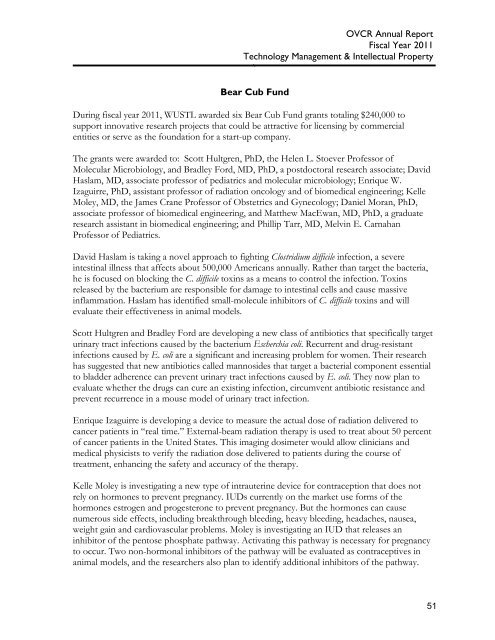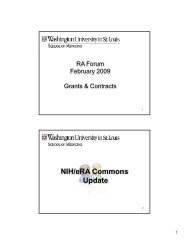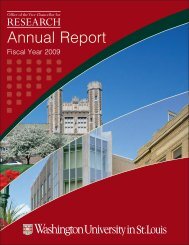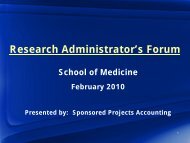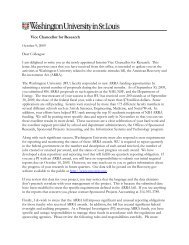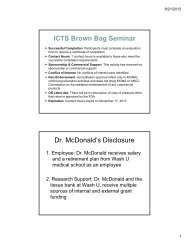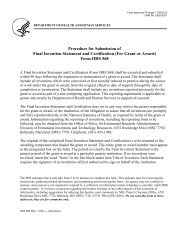A Letter from The Office of the Vice Chancellor for Research
A Letter from The Office of the Vice Chancellor for Research
A Letter from The Office of the Vice Chancellor for Research
Create successful ePaper yourself
Turn your PDF publications into a flip-book with our unique Google optimized e-Paper software.
OVCR Annual ReportFiscal Year 2011Technology Management & Intellectual PropertyBear Cub FundDuring fiscal year 2011, WUSTL awarded six Bear Cub Fund grants totaling $240,000 tosupport innovative research projects that could be attractive <strong>for</strong> licensing by commercialentities or serve as <strong>the</strong> foundation <strong>for</strong> a start-up company.<strong>The</strong> grants were awarded to: Scott Hultgren, PhD, <strong>the</strong> Helen L. Stoever Pr<strong>of</strong>essor <strong>of</strong>Molecular Microbiology, and Bradley Ford, MD, PhD, a postdoctoral research associate; DavidHaslam, MD, associate pr<strong>of</strong>essor <strong>of</strong> pediatrics and molecular microbiology; Enrique W.Izaguirre, PhD, assistant pr<strong>of</strong>essor <strong>of</strong> radiation oncology and <strong>of</strong> biomedical engineering; KelleMoley, MD, <strong>the</strong> James Crane Pr<strong>of</strong>essor <strong>of</strong> Obstetrics and Gynecology; Daniel Moran, PhD,associate pr<strong>of</strong>essor <strong>of</strong> biomedical engineering, and Mat<strong>the</strong>w MacEwan, MD, PhD, a graduateresearch assistant in biomedical engineering; and Phillip Tarr, MD, Melvin E. CarnahanPr<strong>of</strong>essor <strong>of</strong> Pediatrics.David Haslam is taking a novel approach to fighting Clostridium difficile infection, a severeintestinal illness that affects about 500,000 Americans annually. Ra<strong>the</strong>r than target <strong>the</strong> bacteria,he is focused on blocking <strong>the</strong> C. difficile toxins as a means to control <strong>the</strong> infection. Toxinsreleased by <strong>the</strong> bacterium are responsible <strong>for</strong> damage to intestinal cells and cause massiveinflammation. Haslam has identified small-molecule inhibitors <strong>of</strong> C. difficile toxins and willevaluate <strong>the</strong>ir effectiveness in animal models.Scott Hultgren and Bradley Ford are developing a new class <strong>of</strong> antibiotics that specifically targeturinary tract infections caused by <strong>the</strong> bacterium Escherchia coli. Recurrent and drug-resistantinfections caused by E. coli are a significant and increasing problem <strong>for</strong> women. <strong>The</strong>ir researchhas suggested that new antibiotics called mannosides that target a bacterial component essentialto bladder adherence can prevent urinary tract infections caused by E. coli. <strong>The</strong>y now plan toevaluate whe<strong>the</strong>r <strong>the</strong> drugs can cure an existing infection, circumvent antibiotic resistance andprevent recurrence in a mouse model <strong>of</strong> urinary tract infection.Enrique Izaguirre is developing a device to measure <strong>the</strong> actual dose <strong>of</strong> radiation delivered tocancer patients in “real time.” External-beam radiation <strong>the</strong>rapy is used to treat about 50 percent<strong>of</strong> cancer patients in <strong>the</strong> United States. This imaging dosimeter would allow clinicians andmedical physicists to verify <strong>the</strong> radiation dose delivered to patients during <strong>the</strong> course <strong>of</strong>treatment, enhancing <strong>the</strong> safety and accuracy <strong>of</strong> <strong>the</strong> <strong>the</strong>rapy.Kelle Moley is investigating a new type <strong>of</strong> intrauterine device <strong>for</strong> contraception that does notrely on hormones to prevent pregnancy. IUDs currently on <strong>the</strong> market use <strong>for</strong>ms <strong>of</strong> <strong>the</strong>hormones estrogen and progesterone to prevent pregnancy. But <strong>the</strong> hormones can causenumerous side effects, including breakthrough bleeding, heavy bleeding, headaches, nausea,weight gain and cardiovascular problems. Moley is investigating an IUD that releases aninhibitor <strong>of</strong> <strong>the</strong> pentose phosphate pathway. Activating this pathway is necessary <strong>for</strong> pregnancyto occur. Two non-hormonal inhibitors <strong>of</strong> <strong>the</strong> pathway will be evaluated as contraceptives inanimal models, and <strong>the</strong> researchers also plan to identify additional inhibitors <strong>of</strong> <strong>the</strong> pathway.51


